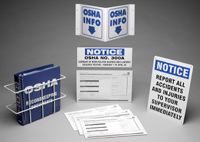 |
 |
| MSDS Topics |
Free Sites | FAQ's | Regulations | Glossary | Software | Suppliers |
| Books | Forum | Poll | Fun stuff | Quiz | Store | |
| MSDS and safety supplies | Search ALL our MSDS info | |||||
 | |||
 |
 |
 |
|
| Title: 11/27/1990 - Employee exposure to consumer products. | |
| Record Type: Interpretation | Standard Number: 1910.1200 |
November 27, 1990
Mr. Dan J. Helm
Compliance Software/Haz-I-Dent
1721 Stuart Court
Duluth, Minnesota 55803
Dear Mr. Helm:
Thank you for your letter, received in this office October 2, regarding employee exposure to consumer products under the Occupational Safety and Health Administration's (OSHA) Hazard Communication Standard (HCS), 29 CFR 1910.1200.
You specifically requested "written documentation ... regarding commercial use of consumer products." On October 22, the newly revised Hazard Communication compliance directive, OSHA Instruction CPL 2-2.38C, was issued. This directive, entitled "Inspection Procedures for the Hazard Communication Standard," contains compliance guidelines, clarifications and interpretations on all provisions of the standard, including the Agency's enforcement policies regarding workplace use of consumer products.
A copy of CPL 2-2.38C is enclosed for your information and reference on this and other hazard communication related issues. Please note that this OSHA Instruction is not a "rule", per se, as you refer to in your letter. OSHA Instructions provide interpretative guidance and Agency enforcement policies which are particularly relevant and helpful for this "performance oriented" standard.
Occupational exposure to consumer products is covered under the HCS when the employee's use results in exposures to the chemical that are more frequent or of a longer duration than would be expected from normal consumer use (see narrative discussion on this issue in Appendix of A, CPL 2-2.38C, page 5). In addition, pages 3-4 of the Instruction contain information regarding the Supreme Court decision of February 21 of this year, the effect of which is full enforcement of the HCS with regard to the three previously stayed provisions of the standard, including the applicability of the rule to consumer products used in the workplace (see section H., "Background").
|
You posed a second question to the Agency: "Would it be a better standard (better for employees, easier for employers to understand, easier to enforce and clearer), to apply the Hazard Communication Standard to all chemicals used by employees?" OSHA and the Department of Labor are precluded under Section 4(b)(1) of the Occupational Safety and Health Act of 1970 (OSH Act) from exercising "statutory authority to prescribe or enforce standards or regulations'' over areas or issues that other Federal agencies already "prescribe or enforce." The Consumer Product Safety Act (15 U.S.C. 2051 et seq.) and the Federal Hazardous Substances Act (15 U.S.C. 1261 et seq.) regulate the use of consumer products and/or hazardous substances outside the workplace. The labeling, therefore, of consumer products is under the Consumer Product Safety Commission's authority, while the requirement to provide MSDSs and train employees in their safe handling in the workplace falls under OSHA's jurisdiction if, again, their use is of a greater frequency or duration (and therefore a greater exposure risk) than what a normal consumer would experience. We hope this discussion and enclosed material will be helpful to you. For your future reference, you may want to contact our Chicago Regional Office at (312) 353-2220 with any further questions on Hazard Communication. Each OSHA Regional Office has a Hazard Communication Coordinator, and, in Chicago, that person is Ms. Ann Williams. She would be happy to help you with any further questions you may have. The Chicago Regional Office's address is: |  Workplaces with 11 or more employees have to comply with OSHA 300 work-related injury reporting requirements. Get your compliance materials at Safety Emporium. |
Sincerely,
Patricia K. Clark, Director
Directorate of Compliance Programs
The official, public domain, OSHA version of this document is available at http://www.osha.gov/pls/oshaweb/owadisp.show_document?p_table=INTERPRETATIONS&p_id=20134&p_text_version=FALSE